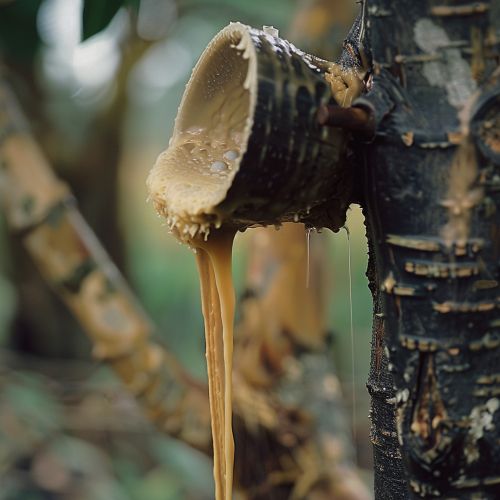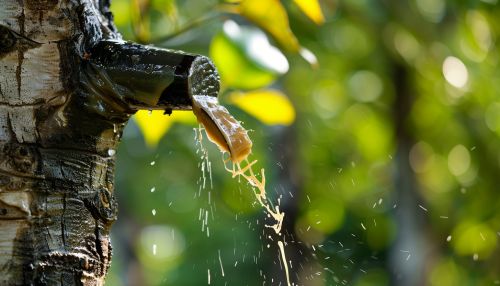Rubber tree
Overview
The rubber tree, scientifically known as Hevea brasiliensis, is a species of tree in the family Euphorbiaceae. It is native to the Amazon rainforest and is the primary source of natural rubber. The rubber tree is cultivated extensively in tropical regions around the world, particularly in Southeast Asia, Africa, and South America. This article delves into the biology, cultivation, economic significance, and environmental impact of the rubber tree.
Biology
Taxonomy and Classification
The rubber tree belongs to the genus Hevea within the family Euphorbiaceae. The genus Hevea comprises ten species, but Hevea brasiliensis is the most commercially significant. The species was first described by Carl Friedrich Philipp von Martius in 1832.
Morphology
The rubber tree is a tall, deciduous tree that can grow up to 30 meters in height. It has a straight trunk with a smooth, greyish bark. The leaves are compound, consisting of three leaflets arranged in a palmate fashion. The flowers are small and inconspicuous, with separate male and female flowers on the same tree.


Latex Production
The most notable feature of the rubber tree is its ability to produce latex, a milky fluid that contains rubber particles. Latex is produced in specialized cells called laticifers, which are found in the bark of the tree. When the bark is tapped, latex flows out and can be collected for processing into natural rubber.
Reproduction
Rubber trees reproduce both sexually and asexually. Sexual reproduction occurs through the production of seeds, which are dispersed by wind and animals. Asexual reproduction, or vegetative propagation, is commonly used in commercial plantations to produce clones of high-yielding trees.
Cultivation
History
The cultivation of rubber trees began in the Amazon rainforest, where indigenous peoples used latex for various purposes. In the late 19th century, rubber seeds were smuggled out of Brazil and introduced to British colonies in Southeast Asia. This led to the establishment of large-scale rubber plantations in countries such as Malaysia, Indonesia, and Thailand.
Planting and Maintenance
Rubber trees are typically planted in rows with a spacing of about 3 meters between trees. They require a warm, humid climate with well-drained soil. Regular maintenance includes weeding, fertilization, and pest control. Tapping, the process of extracting latex, begins when the trees are about 5-7 years old and continues for up to 30 years.
Harvesting
Tapping involves making a series of incisions in the bark of the tree to allow latex to flow out. The latex is collected in cups and then processed to remove impurities and coagulate the rubber particles. This raw rubber is then further processed into various forms for commercial use.
Economic Significance
Global Production
Natural rubber is a critical raw material for many industries, including automotive, healthcare, and manufacturing. The leading producers of natural rubber are Thailand, Indonesia, and Vietnam, which together account for over 70% of global production.
Market Dynamics
The price of natural rubber is influenced by various factors, including supply and demand, weather conditions, and geopolitical events. The rubber market is also affected by the availability of synthetic rubber, which is produced from petroleum-based materials.
Applications
Natural rubber is used in a wide range of products, including tires, gloves, medical devices, and adhesives. Its unique properties, such as elasticity, resilience, and resistance to abrasion, make it indispensable in many applications.
Environmental Impact
Deforestation
The expansion of rubber plantations has led to significant deforestation, particularly in Southeast Asia. This has resulted in the loss of biodiversity and disruption of ecosystems. Efforts are being made to promote sustainable rubber production practices to mitigate these impacts.
Carbon Sequestration
Rubber trees play a role in carbon sequestration, as they absorb carbon dioxide from the atmosphere during photosynthesis. However, the overall environmental benefits are offset by the deforestation and land-use changes associated with rubber cultivation.
Soil and Water Management
Rubber plantations can affect soil and water resources. Monoculture plantations often lead to soil degradation and reduced water quality. Sustainable practices, such as intercropping and agroforestry, are being explored to improve soil health and water management.
